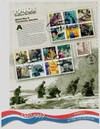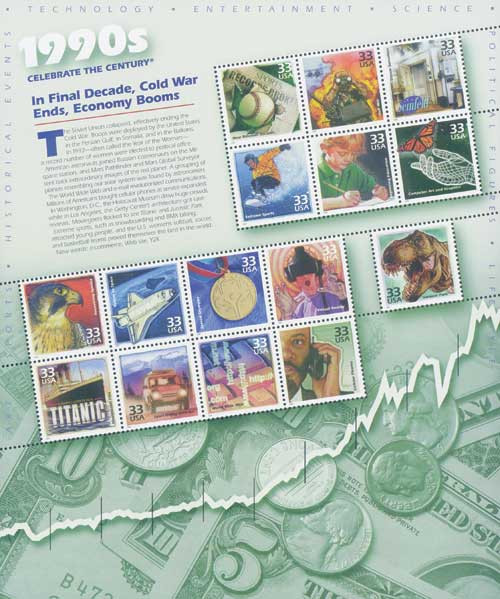
# 3186 - 1999 33c Celebrate the Century: 1940s
US #3186
1999 Celebrate the Century (1940s)
• The fifth sheet in the Celebrate the Century stamp series issued from 1998-2000
• Includes 15 stamps picturing important events from the 1940s
• Each stamp has text on the back detailing the event shown in the front design
Stamp Category: Commemorative
Series: Celebrate the Century
Value: 32¢ First Class Mail Rate
First Day of Issue: February 18, 1999
First Day City: Dobbins Air Force Base, Georgia
Quantity Issued: 188,000,000
Printed by: Ashton Potter (USA) Ltd.
Printing Method: Offset, Intaglio
Format: Panes of 15
Perforations: 11.5
Tagging: Block Tagging
Why the stamps were issued: To commemorate important historical and cultural events from the 1940s that have a lasting legacy in the United States.
About the stamp designs: Picture artwork by Howard Koslow of Toms River, New Jersey. The following topics were chosen for the 15 stamps on this sheet (and corresponding back markings of each):
World War II – More than 16 million Americans served in the armed forces during World War II, and more than 405,000 lost their lives. U.S. intervention proved decisive in the Allied victories in Europe and in the Pacific.
Antibiotics Save Lives – Antibiotics are used to treat bacterial infections. Penicillin, derived from mold as shown on reverse, saved the lives of thousands of wounded soldiers during World War II. Postwar streptomycin has been highly effective in combating tuberculosis.
Jackie Robinson – Jackie Robinson broke the Major League Baseball color barrier in 1947 wen he joined the Brooklyn Dodgers. Voted Rookie of the Year that season, he earned the National league’s Most Valuable Player award in 1949.
President Harry S. Truman – The 33rd president, harry S. Truman, guided the nation through the end of World War II and the beginning of the Cold War. A sign, which reportedly sat on his desk in his office at the White House, read: ‘The BUCK STOPS here!”
Women Support War Effort – When millions of men joined the armed forces, millions of women took over factory jobs and made up more than one-third of the civilian workforce. Millions of women also served as volunteers.
TV Entertains America – Commercial television formally began July 1, 1941, and by the end of 1949 more than three million American homes had sets. Many early programs, including dramas, variety shows, news shows, and comedies, were adapted from popular radio programs.
Jitterbug Sweeps Nation – Bridging the eras of swing and rock ‘n’ roll, the jitterbug was a fast-paced dance performed to live music played by bands, and to recorded music played on jukeboxes. It was popular with GIs, teenagers, and anyone else able to keep the beat.
Abstract Expressionism – Abstract Expressionism was marked by a range of individual styles of modern painting and sculpture. Jackson Pollock (1912-1956) created his most famous gestural abstractions by pouring paint onto canvas laid on his studio floor.
GI Bill 1944 – The Servicemen’s Readjustment Act of 1944, better known as the GI Bill, helped approximately 2.25 million war veterans attend college. Millions of other GIs received job training; home, business, and farm loans; and unemployment benefits.
The Big Band Sound – Big band music, popular on recordings and radio and in ballrooms and concert halls, distracted Americans during World War II. Led by Duke Ellington, Glenn Miller, Benny Goodman, Count Basie, and others, the bands usually had 14 to 18 musicians.
International Style of Architecture – Concerned with function and simple shapes, the International Style employed materials such as glass, steel, and concrete. Its long-lasting influence is visible in the United Nations Secretariat and countless other office and apartment buildings.
Postwar Baby Boom – The detail from the November 2, 1946, cover of The Saturday Evening Post foretells the country’s baby boom. With the end of World War II, returning GIs married and started families, resulting in 75.9 million births from 1946 through 1964.
Slinky Craze Begins 1945 – Naval engineer Richard James watched a torsion spring bounce off a table, and the idea for a toy was born. The Slinky, 80 feet of coiled wire that can “walk” down stairs, caused a sensation when first marketed in 1945.
“A Streetcar Named Desire” – Broadway Hit 1947 – Tenessee Williams’ powerful play, “A Streetcar Named Desire” opened on Broadway December 3, 1947. It starred Marlon Brando as Stanley Kowalski and Jessica Tandy as Blanche DuBois. The play won the 1948 Pulitzer Prize for drama.
Orsen Welles’ “Citizen Kane” – Released in 1941, Orson Welles’ “Citizen Kane” was hailed for its artistic and technical innovations. The psychological study of a newspaper tycoon, it has consistently been considered one of the best movies in the history of film.
First Day City: The First Day of Issue Ceremony was held at the Dobbins Air Force Base Fuel Cell Hangar in Georgia.
About the Celebrate the Century series: The USPS launched the Celebrate the Century series in 1998 to mark the end of the 20th century and herald the arrival of the 21st. The series includes 10 sheets of 15 stamps (150 in total), with each honoring important moments from a different decade (1900s, 10s, 20s, 30s, 40s, 50s, 60s, 70s, 80s, and 90s). At the time of completion, it was the longest and most ambitious commemorative stamp series in US history.
US #3186
1999 Celebrate the Century (1940s)
• The fifth sheet in the Celebrate the Century stamp series issued from 1998-2000
• Includes 15 stamps picturing important events from the 1940s
• Each stamp has text on the back detailing the event shown in the front design
Stamp Category: Commemorative
Series: Celebrate the Century
Value: 32¢ First Class Mail Rate
First Day of Issue: February 18, 1999
First Day City: Dobbins Air Force Base, Georgia
Quantity Issued: 188,000,000
Printed by: Ashton Potter (USA) Ltd.
Printing Method: Offset, Intaglio
Format: Panes of 15
Perforations: 11.5
Tagging: Block Tagging
Why the stamps were issued: To commemorate important historical and cultural events from the 1940s that have a lasting legacy in the United States.
About the stamp designs: Picture artwork by Howard Koslow of Toms River, New Jersey. The following topics were chosen for the 15 stamps on this sheet (and corresponding back markings of each):
World War II – More than 16 million Americans served in the armed forces during World War II, and more than 405,000 lost their lives. U.S. intervention proved decisive in the Allied victories in Europe and in the Pacific.
Antibiotics Save Lives – Antibiotics are used to treat bacterial infections. Penicillin, derived from mold as shown on reverse, saved the lives of thousands of wounded soldiers during World War II. Postwar streptomycin has been highly effective in combating tuberculosis.
Jackie Robinson – Jackie Robinson broke the Major League Baseball color barrier in 1947 wen he joined the Brooklyn Dodgers. Voted Rookie of the Year that season, he earned the National league’s Most Valuable Player award in 1949.
President Harry S. Truman – The 33rd president, harry S. Truman, guided the nation through the end of World War II and the beginning of the Cold War. A sign, which reportedly sat on his desk in his office at the White House, read: ‘The BUCK STOPS here!”
Women Support War Effort – When millions of men joined the armed forces, millions of women took over factory jobs and made up more than one-third of the civilian workforce. Millions of women also served as volunteers.
TV Entertains America – Commercial television formally began July 1, 1941, and by the end of 1949 more than three million American homes had sets. Many early programs, including dramas, variety shows, news shows, and comedies, were adapted from popular radio programs.
Jitterbug Sweeps Nation – Bridging the eras of swing and rock ‘n’ roll, the jitterbug was a fast-paced dance performed to live music played by bands, and to recorded music played on jukeboxes. It was popular with GIs, teenagers, and anyone else able to keep the beat.
Abstract Expressionism – Abstract Expressionism was marked by a range of individual styles of modern painting and sculpture. Jackson Pollock (1912-1956) created his most famous gestural abstractions by pouring paint onto canvas laid on his studio floor.
GI Bill 1944 – The Servicemen’s Readjustment Act of 1944, better known as the GI Bill, helped approximately 2.25 million war veterans attend college. Millions of other GIs received job training; home, business, and farm loans; and unemployment benefits.
The Big Band Sound – Big band music, popular on recordings and radio and in ballrooms and concert halls, distracted Americans during World War II. Led by Duke Ellington, Glenn Miller, Benny Goodman, Count Basie, and others, the bands usually had 14 to 18 musicians.
International Style of Architecture – Concerned with function and simple shapes, the International Style employed materials such as glass, steel, and concrete. Its long-lasting influence is visible in the United Nations Secretariat and countless other office and apartment buildings.
Postwar Baby Boom – The detail from the November 2, 1946, cover of The Saturday Evening Post foretells the country’s baby boom. With the end of World War II, returning GIs married and started families, resulting in 75.9 million births from 1946 through 1964.
Slinky Craze Begins 1945 – Naval engineer Richard James watched a torsion spring bounce off a table, and the idea for a toy was born. The Slinky, 80 feet of coiled wire that can “walk” down stairs, caused a sensation when first marketed in 1945.
“A Streetcar Named Desire” – Broadway Hit 1947 – Tenessee Williams’ powerful play, “A Streetcar Named Desire” opened on Broadway December 3, 1947. It starred Marlon Brando as Stanley Kowalski and Jessica Tandy as Blanche DuBois. The play won the 1948 Pulitzer Prize for drama.
Orsen Welles’ “Citizen Kane” – Released in 1941, Orson Welles’ “Citizen Kane” was hailed for its artistic and technical innovations. The psychological study of a newspaper tycoon, it has consistently been considered one of the best movies in the history of film.
First Day City: The First Day of Issue Ceremony was held at the Dobbins Air Force Base Fuel Cell Hangar in Georgia.
About the Celebrate the Century series: The USPS launched the Celebrate the Century series in 1998 to mark the end of the 20th century and herald the arrival of the 21st. The series includes 10 sheets of 15 stamps (150 in total), with each honoring important moments from a different decade (1900s, 10s, 20s, 30s, 40s, 50s, 60s, 70s, 80s, and 90s). At the time of completion, it was the longest and most ambitious commemorative stamp series in US history.
















